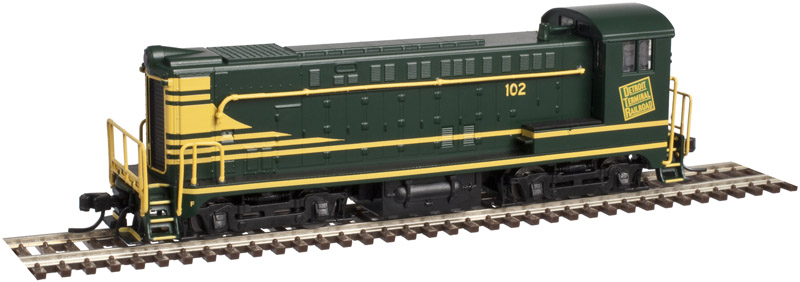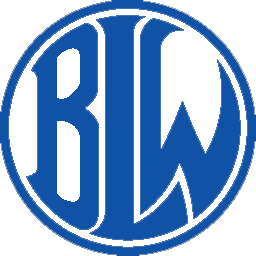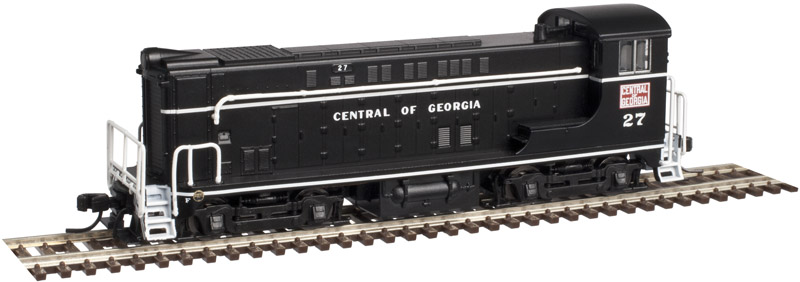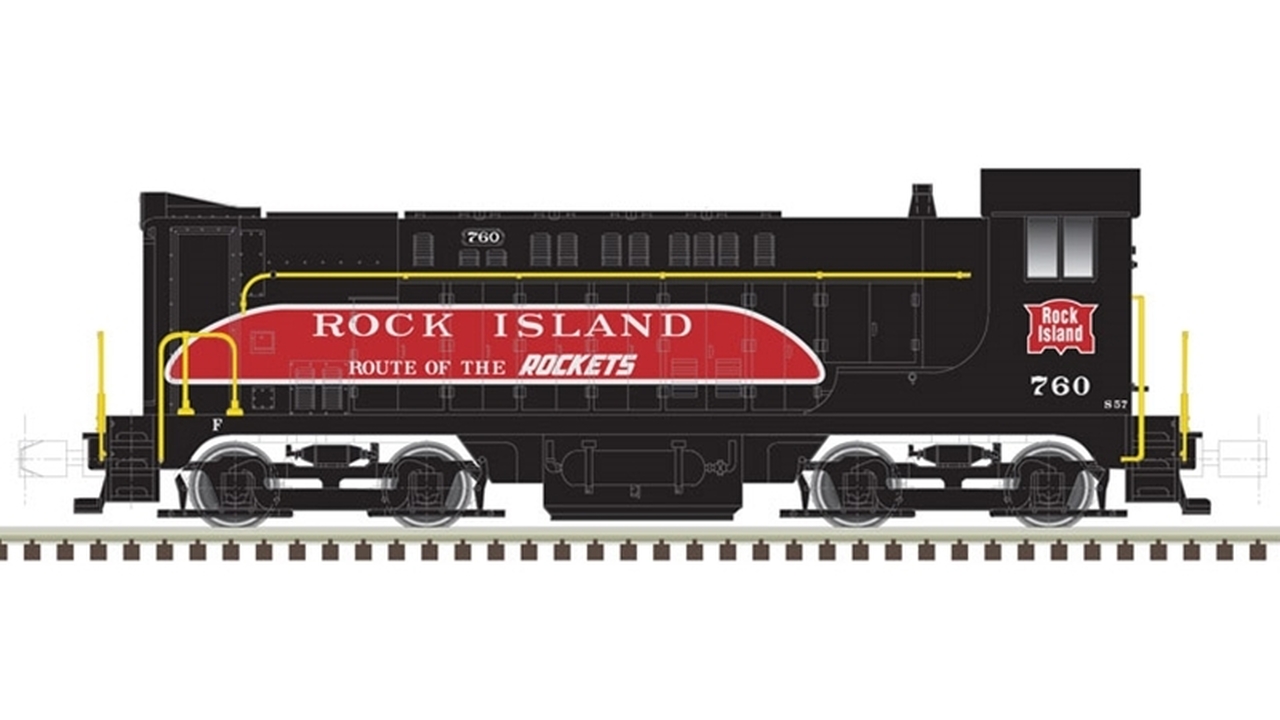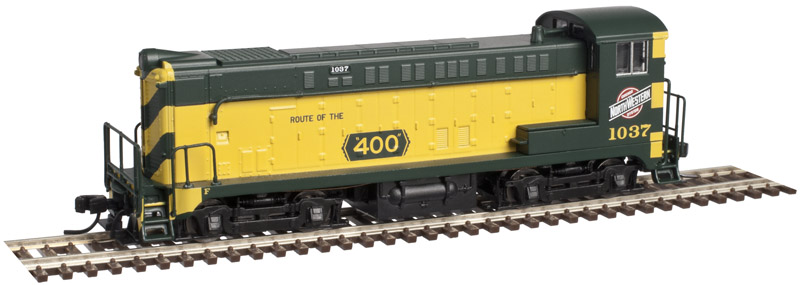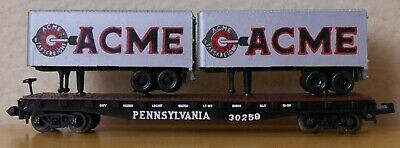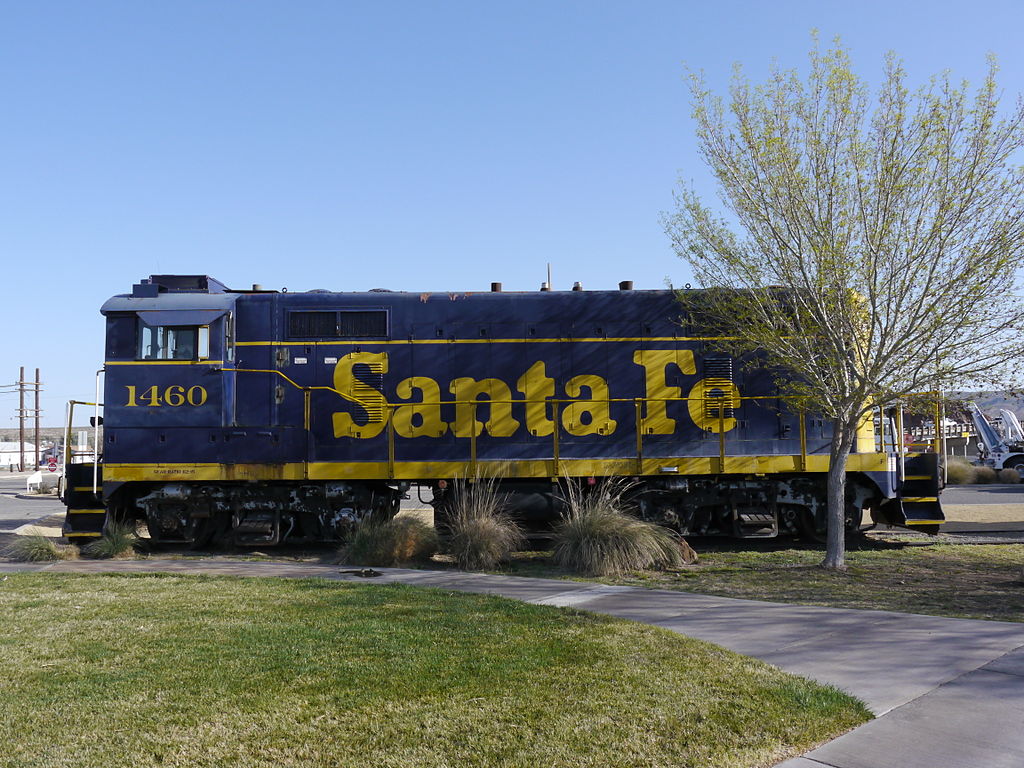Prototype History: The Baldwin VO-1000 was a diesel-electric locomotive (switcher) built by Baldwin Locomotive Works between January, 1939 and December, 1946. The 236,260–242,200 lb (107,170–109,860 kg) units were powered by a normally aspirated eight-cylinder diesel engine rated at 1,000 horsepower (746 kW), and rode on a pair of two-axle trucks in a B-B wheel arrangement. These were either the AAR Type-A switcher trucks, or the Batz truck originally developed by the Atchison, Topeka and Santa Fe Railway as a leading truck for steam locomotives. 548 examples of this model were built for American railroads, including examples for the Army and Navy.
Between June and August, 1945 Baldwin supplied 30 Co-Co road locomotives with 8-cylinder VO engines for export to the Soviet Union as their Дб20 (Db20) class.
There are at least eight intact examples of the VO-1000 that are known to survive today, most of which are owned by museums or historical societies. However, a VO-1000m is owned by the Northwestern Pacific Railroad, a local freight carrier based out of Schellville, California.
From Wikipedia
Between June and August, 1945 Baldwin supplied 30 Co-Co road locomotives with 8-cylinder VO engines for export to the Soviet Union as their Дб20 (Db20) class.
There are at least eight intact examples of the VO-1000 that are known to survive today, most of which are owned by museums or historical societies. However, a VO-1000m is owned by the Northwestern Pacific Railroad, a local freight carrier based out of Schellville, California.
From Wikipedia
Road Name History: 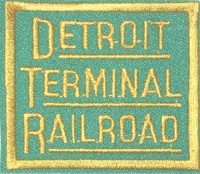 Detroit Terminal Railroad Company was incorporated in the State of Michigan, United States of America, on December 7, 1905 to own railroad track forming a semi-circle around the City of Detroit. It existed as a railroad until it was merged into its parent company, Consolidated Rail Corp., on May 31, 1984.
Detroit Terminal Railroad Company was incorporated in the State of Michigan, United States of America, on December 7, 1905 to own railroad track forming a semi-circle around the City of Detroit. It existed as a railroad until it was merged into its parent company, Consolidated Rail Corp., on May 31, 1984.
By 1905 many of the prime industrial locations in the City of Detroit located on railroad lines were already taken, causing an impediment to the development of the automotive and other industries being created at that time. Detroit Terminal Railroad's trackage extended around the City of Detroit in what is called a "belt line," reaching rural undeveloped locations in order to open up opportunities for new industrial development in the rapidly growing city. Originally planned but never accomplished was a railroad-operated "car ferry" operation to sail the Detroit River to distribute freight at the many docks located along the river that were inaccessible to railway shipping.
Freight movement on the Detroit Terminal Railroad steadily increased up to 1950 fed largely by the development, growth and maturation of the automotive industry in Detroit. Business remained stable throughout the 1950s then slowly started dropping off starting in the 1960s. By 1968 the alarm bells were ringing at Detroit Terminal Railroad's business offices as carloadings had dropped dramatically from a peak of 151,914 in 1953 to 57,543 in 1967. This was a result of changing ways of urban living (natural gas to heat homes instead of railroad-hauled coal) to the closing of major automotive plants in Detroit (DeSoto and Hudson) and also due to the use of large, hi-capacity ("hi-cube" and "autorack") freight cars especially by the automotive companies replacing two or three smaller freight cars needed before. Revenue per freight car moved almost doubled between 1953 and 1967 but operating expenses per freight car moved tripled in this period. Employment drop from 358 in 1953 to 227 in 1967 and salaries took up 98% of operating revenue in 1967. In 1967 there was an estimated $2.5 million in deferred maintenance to tracks and equipment. Blame was placed on poor management of the railroad by its two railroad owners (Michigan Central and Lake Shore & Michigan Southern had merged into the New York Central by this time) who were not paying enough attention to the railroad. Also "deteriorating social conditions" culminating in the 1967 race riots in Detroit at the time were causing an exodus of industries located on the railroad further reducing carloadings.
By the late 1970s on-line business had rapidly declined on the Detroit Terminal Railroad. With railroad consolidation occurring in Detroit as well as nationwide the use of the Detroit Terminal Railroad for the interchange purposes of its two owners had also declined and in 1980 Grand Trunk Western sold its 50% interest in Detroit Terminal Railroad to its other owner, Consolidated Rail Corporation (Conrail). Conrail operated it for a year then, in August 1981, combined Detroit Terminal Railroad operations with its own railroad operations out of its North Yard in Detroit. Over the next couple years Conrail cut back on operating the former Detroit Terminal Railroad trackage and eventually stopped operating over its west end (which, for a while, it accessed from its Livernois Yard at a newly reinstalled connecting track). Today Conrail (Shared Assets) still runs daily trains over what was the east end of the Detroit Terminal Railroad to service a Jeep manufacturing plant owned by Chrysler Group LLC. On May 31, 1984 Conrail legally merged Detroit Terminal Railroad into itself, officially ending 79 years of continuous operation by Detroit's only terminal railroad.

By 1905 many of the prime industrial locations in the City of Detroit located on railroad lines were already taken, causing an impediment to the development of the automotive and other industries being created at that time. Detroit Terminal Railroad's trackage extended around the City of Detroit in what is called a "belt line," reaching rural undeveloped locations in order to open up opportunities for new industrial development in the rapidly growing city. Originally planned but never accomplished was a railroad-operated "car ferry" operation to sail the Detroit River to distribute freight at the many docks located along the river that were inaccessible to railway shipping.
Freight movement on the Detroit Terminal Railroad steadily increased up to 1950 fed largely by the development, growth and maturation of the automotive industry in Detroit. Business remained stable throughout the 1950s then slowly started dropping off starting in the 1960s. By 1968 the alarm bells were ringing at Detroit Terminal Railroad's business offices as carloadings had dropped dramatically from a peak of 151,914 in 1953 to 57,543 in 1967. This was a result of changing ways of urban living (natural gas to heat homes instead of railroad-hauled coal) to the closing of major automotive plants in Detroit (DeSoto and Hudson) and also due to the use of large, hi-capacity ("hi-cube" and "autorack") freight cars especially by the automotive companies replacing two or three smaller freight cars needed before. Revenue per freight car moved almost doubled between 1953 and 1967 but operating expenses per freight car moved tripled in this period. Employment drop from 358 in 1953 to 227 in 1967 and salaries took up 98% of operating revenue in 1967. In 1967 there was an estimated $2.5 million in deferred maintenance to tracks and equipment. Blame was placed on poor management of the railroad by its two railroad owners (Michigan Central and Lake Shore & Michigan Southern had merged into the New York Central by this time) who were not paying enough attention to the railroad. Also "deteriorating social conditions" culminating in the 1967 race riots in Detroit at the time were causing an exodus of industries located on the railroad further reducing carloadings.
By the late 1970s on-line business had rapidly declined on the Detroit Terminal Railroad. With railroad consolidation occurring in Detroit as well as nationwide the use of the Detroit Terminal Railroad for the interchange purposes of its two owners had also declined and in 1980 Grand Trunk Western sold its 50% interest in Detroit Terminal Railroad to its other owner, Consolidated Rail Corporation (Conrail). Conrail operated it for a year then, in August 1981, combined Detroit Terminal Railroad operations with its own railroad operations out of its North Yard in Detroit. Over the next couple years Conrail cut back on operating the former Detroit Terminal Railroad trackage and eventually stopped operating over its west end (which, for a while, it accessed from its Livernois Yard at a newly reinstalled connecting track). Today Conrail (Shared Assets) still runs daily trains over what was the east end of the Detroit Terminal Railroad to service a Jeep manufacturing plant owned by Chrysler Group LLC. On May 31, 1984 Conrail legally merged Detroit Terminal Railroad into itself, officially ending 79 years of continuous operation by Detroit's only terminal railroad.
Brand/Importer Information: In 1924 Stephan Schaffan, Sr. founded the Atlas Tool Company in Newark, New Jersey. In 1933 his son, Stephan Schaffan, Jr., came to work for his father at the age of sixteen. Steve Jr. built model airplanes as a hobby and frequented a local hobby shop. Being an enterprising young man, he would often ask the owner if there was anything he could do to earn some extra spending money. Tired of listening to his requests, the hobby-store owner threw some model railroad track parts his way and said, "Here, see if you can improve on this".
In those days, railroad modelers had to assemble and build everything from scratch. Steve Jr. created a "switch kit" which sold so well, that the entire family worked on them in the basement at night, while doing business as usual in the machine shop during the day.
Subsequently, Steve Jr. engineered the stapling of rail to fiber track, along with inventing the first practical rail joiner and pre-assembled turnouts and flexible track. All of these products, and more, helped to popularize model railroading and assisted in the creation of a mass-market hobby. The budding entrepreneur quickly outgrew the limitations of a basement and small garage operation. Realizing they could actually make a living selling track and related products, Steve and his father had the first factory built in Hillside, New Jersey at 413 Florence Avenue in 1947. On September 30, 1949, the Atlas Tool Company was officially incorporated as a New Jersey company.
In 1985, Steve was honored posthumously for his inventions by the Model Railroad Industry Association and was inducted into the Model Railroad Industry Hall of Fame in Baltimore, Maryland. In addition, Steve was nominated and entered into the National Model Railroad Association Pioneers of Model Railroading in 1995.
In the early 1990s, the Atlas Tool Company changed its name to Atlas Model Railroad Company, Inc.
In those days, railroad modelers had to assemble and build everything from scratch. Steve Jr. created a "switch kit" which sold so well, that the entire family worked on them in the basement at night, while doing business as usual in the machine shop during the day.
Subsequently, Steve Jr. engineered the stapling of rail to fiber track, along with inventing the first practical rail joiner and pre-assembled turnouts and flexible track. All of these products, and more, helped to popularize model railroading and assisted in the creation of a mass-market hobby. The budding entrepreneur quickly outgrew the limitations of a basement and small garage operation. Realizing they could actually make a living selling track and related products, Steve and his father had the first factory built in Hillside, New Jersey at 413 Florence Avenue in 1947. On September 30, 1949, the Atlas Tool Company was officially incorporated as a New Jersey company.
In 1985, Steve was honored posthumously for his inventions by the Model Railroad Industry Association and was inducted into the Model Railroad Industry Hall of Fame in Baltimore, Maryland. In addition, Steve was nominated and entered into the National Model Railroad Association Pioneers of Model Railroading in 1995.
In the early 1990s, the Atlas Tool Company changed its name to Atlas Model Railroad Company, Inc.
Item created by: gdm on 2016-04-02 12:52:51. Last edited by CNW400 on 2020-07-27 09:58:12
If you see errors or missing data in this entry, please feel free to log in and edit it. Anyone with a Gmail account can log in instantly.
If you see errors or missing data in this entry, please feel free to log in and edit it. Anyone with a Gmail account can log in instantly.


